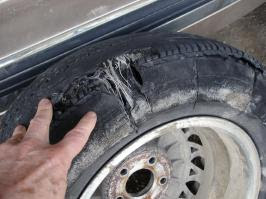Going back to our initial question, there is no shame in not knowing this because as in most things in our part of the world, we are neither taught nor told and so we live perpetually in ignorance and wishes. As have been emphasized in many articles in this blog, safety is not all about wishes and prayers, but current knowledge and practice of what is safe and sensible.


For this first part of our discussion on tyre safety, we will look at just one aspect of these facotrs that control the safety of tyres in our vehicles.
Manufacture & Expiration Date of Tyres
As part of quality assurrance of vehicle's tyres, manufacturing dates are written on the sidewall of all original tyres. As a general rule, tyres will start serious level of deterioration after 4 years of manufacture. Depending on use and other factors therefore, expiration will commence from 4-6 years at the maximum after which the tyres must be destroyed or recycled for other uses. Please note that the date of expiration is not written on the tyres but as a user, it is your responsibility to use the date of manufacture as your guide to determining the year of expiration.
To read the manufacture dates on a tyre therefore, the following steps will be a useful guide:
- Locate the DOT number on the sidewall of the tyre. It's easy to find since the first 3 digits are "DOT." They are displayed on both sides of the tyre.
- After the DOT, look for a 10 to 12 digit number. The last four digits will sometimes be place be placed in an oval or circle and will only be numerical.
- Determine the age of the tyres by reading the last four digits of the full DOT number from the sidewall of the tire.

- The first two digits of the four digits date stamp will indicate the week of the year the tyre was manufactured. For example, on the tyre in this picture, “08” means 8th week of the year (this is of course the month of February)
- The last two digits in the date stamp number will determine the year it was manufactured. For example, “06” on the same picture means 2006
- For the above examples therefore, the last four digits of the full DOT number displayed on the sidewall of a tyre “0806” would dictate that the tyre was manufactured in the 8th week of the year 2006.
As a driver, passenger or general user of a vehicle, use this information to determine the age of tyres on your vehicle. Always request to see this number before purchasing any tyre. If these numbers are not on the tyre, then they have been probably removed to deceive buyers and users. It's not uncommon to be purchasing a year or maybe two year old tyres, but the newer the better and compare that to the price you're being charged for them. Tyres will expire even on the shelf no matter how new or beautiful looking it appears.
Please note however that the 4 digits tyre stamp started in the year of 2000. Tyres manufactured earlier than 2000 only have three digits in the tyre stamp and if that's all you have for a tyre stamp, don't worry about how to decode it...just replace the tyres for your own safety because such tyres are definitely over nine years old. However, for the sake of knowledge, a tyre ending in "239" could have been made in the 23rd week of 1989 or 1999. This will ultimately take you to that place (you know where I am referring to) earlier than planned.
Please take care and use tyres that are of good quality and up to date.
Coming soon: TYRE SAFETY (Part 2)